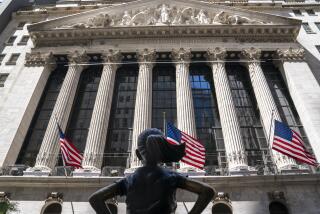Stocks Falter as Bond Yields Head Back Above 6.50%
- Share via
Stocks faltered in a bid for more new highs Thursday as the bond market resumed its recent slide, lifting interest rates further from last week’s 17-month low.
The Dow Jones industrial average skidded 71.31 points to close at 8,188, giving back nearly all of its gain from Wednesday.
Broader indexes also fell, and Nasdaq saw its string of record closes snapped at six sessions.
Analysts cited a weak showing in the bond market as the catalyst for the decline. The 30-year Treasury bond fell, raising its yield to 6.53% from 6.48% on Wednesday. Bond prices and yields move in opposite directions.
“Yields went above 6.50% and that was a perfect excuse for some profit-taking in the market,” said Scott Bleier, chief investment strategist at Prime Charter Ltd.
Analysts said a mixed reception to the Treasury’s sale of $10 billion in 30-year bonds touched off the weakness that sent rates rising.
“The government refinancing was a little disappointing. There wasn’t much buying interest,” said Robert Stovall, president at Stovall/Twenty-First Advisers.
During the last two days, the Treasury sold $12 billion in 10-year notes and $16 billion in three-year notes.
But analysts also noted heightened concern that the economy is picking up more steam than the Federal Reserve Board may be willing to tolerate.
New evidence of the economy’s strength came as some retailers reported generally solid sales for July.
The sales figures may presage strength in next week’s national retail sales data, which are watched closely by Fed policymakers in terms of setting interest rates.
“That’s absolutely going to be one of the more important pieces of data the Fed will look at,” said Bill Meehan, market analyst at Prudential Securities. “So in that respect, today’s figures might be a little bit of a cause for concern.”
Last week, the yield on the 30-year bond fell to 6.30%, its lowest level since February 1996, as bond traders cheered the federal budget agreement.
Fed policymakers are to meet on Aug. 19 to weigh their next move on rates. The central bank raised short-term rates in March--the first increase in more than two years--in a bid to ward off inflation, but it has held rates steady since.
In stock trading, declining issues outnumbered advancers by a 5-4 margin on the New York Stock Exchange, where volume was very heavy.
The Standard & Poor’s 500-stock list fell 9.13 points to 951.19, and the NYSE composite index fell 4.38 points to 492.62. The Nasdaq composite fell 6.26 points to 1,624.18.
The three measures had closed at record highs Wednesday.
Among Thursday’s highlights:
* Several of the Dow’s weakest components were manufacturers of consumer staples: Procter & Gamble fell $2.13 to $146.63, Merck fell $2.25 to $99.75, Coca-Cola fell $1.56 to $66.56 and Johnson & Johnson fell $1.56 to $60.69.
The Dow’s strongest issues included Caterpillar, which rose $2.19 to $60.69 after an upgrade by Merrill Lynch, and AT&T;, which rose $1.06 to $40.13 after an upgrade by Brown Bros. Harriman.
* Shares of the nation’s biggest banks fell as interest rates rose. Higher rates can undermine bank profits. Citicorp declined $3.38 to $136.50, BankAmerica lost $2.25 to $70.50 and Chase Manhattan fell $2.88 to $109.
In currency trading, the dollar fell to 1.8685 German marks from 1.8825 on Wednesday and to 118.45 Japanese yen from 118.68.
The British pound tumbled after the Bank of England signaled that interest rates had risen enough for now. The pound fell to its weakest level since October against the dollar before settling at $1.5900 in New York, down from $1.6033 on Wednesday.
Overseas, Tokyo’s Nikkei stock average fell 1.1%, Frankfurt’s DAX index rose 1.8% and London’s FTSE-100 rose 1.2% to a second straight record.
More to Read
Inside the business of entertainment
The Wide Shot brings you news, analysis and insights on everything from streaming wars to production — and what it all means for the future.
You may occasionally receive promotional content from the Los Angeles Times.










